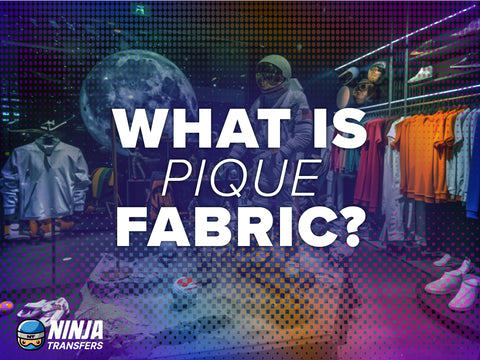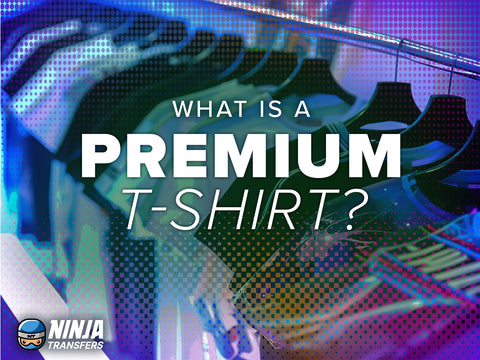If you've ever noticed the unique textured surface on a polo shirt, you were probably looking at Pique fabric. This distinctive material has become so popular in the custom apparel industry with its combination of style, comfort, and durability that it's one of the most ubiquitous types of shirt materials.
This article is your guide into the world of Pique fabric. We look at its distinct characteristics, how it's made, and its diverse uses. For those weighing their fabric options, we compare the different types of Pique, providing insights to help make the best choice for your projects. Read on to discover what makes Pique such a versatile player in the custom apparel game.
Table of Contents
- What Is Pique?
- Different Types Of Pique Fabric
- How Pique Fabric Is Made
- What Pique Is Used For
- Pique Cotton
- Pique Blends
- Pique Polyester
- Printing Considerations
- Sustainability of Pique Fabric
- Conclusion

What Is Pique?
Pique fabric, pronounced as "pee-kay," stands out in the textile world with its distinct raised, waffle-like texture. This isn't just for show; the texture contributes significantly to the fabric's breathability and comfort. "Pique" refers to the weaving method that creates a unique pattern, enhancing the fabric's visual and tactile appeal.
A winning feature of Pique fabric is its moisture-wicking ability, making it an ideal choice for sportswear and activewear, where comfort and dryness are essential. The fabric's textured surface allows better air circulation, aiding in temperature regulation and making it the preferred material for polo shirts.
Beyond moisture management, Pique is appreciated for its durability. The tight weave of this fabric helps it resist snagging and pilling, extending the life of garments and maintaining their look. This resilience and comfort make Pique a solid choice for corporate, casual wear, staff shirts, and more.
Pique is primarily found in 100% cotton or cotton blends, though it can also be blended with synthetic materials like polyester and spandex. The choice of fibers affects characteristics like softness, breathability, and moisture-wicking ability. This variety allows for tailored choices based on specific needs.

Different Types of Pique
Pique fabric comes in various forms, each bringing its own flair and function to the table. Understanding these variations will help you choose the right fabric for your projects. Here are the primary types of Pique:
- Classic Pique: This is the quintessential Pique fabric, instantly recognizable by its signature waffle-like texture. Made typically from 100% cotton or cotton blends, classic Pique offers the best of both worlds – breathability and moisture-wicking properties. It's the fabric you'll find in standard polo shirts and sportswear, reliable and time-tested.
- Baby Pique: Think of it as the softer, subtler cousin of the classic Pique. With a smaller and less pronounced texture, Baby Pique offers a smoother touch, making it ideal for more delicate applications like summer dresses, children's clothing, and lightweight polos.
- Heavyweight Pique: With a denser weave and a more pronounced texture, heavyweight Pique brings added durability and structure suited for outerwear and garments that need to stand up to more rigorous use.
- Stretch Pique: By blending in stretchy fibers such as spandex or elastane, stretch Pique becomes the go-to for active and performance wear. It maintains the classic Pique look, offering enhanced flexibility and more form-fitting comfort.
- Jacquard Pique: Utilizing a specialized jacquard loom, intricate patterns and designs are woven directly into the fabric, creating Pique options that are as visually captivating as they are functional. Jacquard Pique is perfect for premium polos and fashion pieces that demand a touch of sophistication.

How Pique Fabric is Made
The journey from raw materials to the finished Pique fabric is a series of complex processes and careful craftsmanship. Here's a breakdown of the key steps involved in creating this unique textile:
- Yarn Selection: The foundation of Pique fabric begins with the choice of yarn. Most commonly, it's either 100% cotton or a blend of cotton and synthetic fibers like polyester. The yarn's quality significantly affects the fabric's texture, durability, and ability to wick moisture.
- Weaving Process: Pique's trademark texture comes to life during weaving. This involves two sets of yarns: the warp (vertical) and the weft (horizontal). The warp yarns are typically stronger and more tightly twisted to provide structure, while the weft yarns are softer and less twisted, creating the raised waffle-like pattern. This distinct texture is achieved by alternating between tightly and loosely woven sections.
- Knitting for Pique: Not all Pique fabrics are woven. Some, especially those used in polo shirts, are knitted. This method also creates a raised, waffle-like texture but through a unique knitting pattern.
- Finishing Touches: The post-weave production involves several finishing processes:
- Washing: Cleansing the fabric to enhance its softness and drape.
- Dyeing: Adding color to the fabric, if desired.
- Preshrinking: Reducing future shrinkage during normal laundry cycles.
- Softening: Applying chemicals or enzymes for extra softness and comfort.
- Anti-pill treatment: To maintain the fabric's clean appearance over time.
- Quality Control: Pique fabric undergoes rigorous quality control checks throughout its creation. This ensures that the final product consistently meets texture, durability, and performance standards.
What Pique Material is Used For
Pique fabric is a true jack-of-all-trades in the world of textiles, finding its way into a wide range of applications and industries. Here are some of the main ways it's put to use:
- Polo shirts: Pique is synonymous with polo shirts in the custom apparel world. Its textured surface adds a dash of elegance and enhances comfort with its breathability and moisture-wicking qualities. These shirts are popular in business casual settings, sports, and anywhere else you want to look put-together without trying too hard.
- Sports and activewear: The ability of Pique fabric to keep wearers cool and dry makes it a prime choice for sports and activewear. It's commonly used for crafting tennis and golf shirts, running tops, and other performance wear, catering to athletes and fitness enthusiasts who value comfort during physical activities.
- Corporate and promotional wear: Pique polo shirts are a staple in corporate and promotional contexts. Companies often opt for these shirts for their durability and the ease of adding logos or branding, creating a unified, professional image.
- Fashion garments: Beyond its functional roles, Pique fabric shines in the fashion industry. Designers leverage its unique texture and soft drape to create stylish dresses, skirts, and tops, infusing garments with a distinct structured look.

Pique Cotton vs. Pique Blends vs. Pique Polyester
Knowing the differences between cotton, polyester, and blends is key when choosing between different Pique materials. Each type has its own set of attributes that cater to different needs.
Cotton Pique
The classic choice, Pique Cotton, is all about comfort and breathability. Its natural fibers offer a soft touch, making it ideal for everyday wear, from casual polo shirts to comfortable sportswear. The moisture-absorbing properties of cotton make it a preferred choice for warmer climates. However, pure cotton Pique can be prone to wrinkling and may require more maintenance care.
Cotton Pique examples: Premium | Standard | Budget
Pique Blends
These are typically a mix of cotton and synthetic fibers like polyester or elastane. The blend aims to marry the best of both worlds–the comfort and breathability of cotton with the added durability, wrinkle resistance, and shape retention of synthetics. Blended Pique fabrics are often easier to care for and can offer additional functionalities like stretch, making them suited for a wide range of applications, from active sportswear to casual business attire.
Blended Pique examples: Premium | Standard | Budget
Polyester Pique
For those prioritizing durability and ease of maintenance, Pique polyester is the go-to. Polyester fibers bring robustness, resistance to wrinkling, and quick-drying properties, making them a popular choice for activewear and garments that undergo frequent washing. However, it may not offer the same level of breathability and natural feel as cotton, which is something to consider depending on the intended use.
Polyester Pique examples: Premium | Standard | Budget
05:[image: A side-by-side graphic of cotton, blended, and polyester Pique fabrics]
Optimizing Print Quality on Pique
Choosing the right printing technique is crucial when customizing Pique fabric. Its unique textured surface presents specific challenges and opportunities in printing. Here's a quick guide to the appropriate printing methods for Pique fabric, ensuring your designs look great and last long.
Embroidery
Embroidery stands out as the top recommendation for Pique fabric. While adding character to the fabric, the texture of Pique can interfere with traditional printing methods, leading to uneven results. Embroidery, however, complements this texture, offering a high-quality, durable decoration method that withstands wear and washes well. For corporate and other professional branding, it's a clear choice.
Direct-to-Film (DTF)
The most versatile and effective choice for printing on Pique fabrics of all types is DTF transfers. This technique involves printing the design on a special film and then transferring it onto the fabric with heat and pressure. This method provides even coverage over the textured surface and delivers vibrant, enduring colors and details.
An added benefit of DTF printing is its adaptability to different fabric compositions, including cotton, polyester, and blends. Plus, if your Pique fabric includes stretchy fibers like spandex, DTF prints will stretch along, maintaining the integrity and longevity of your design.
Patches
For those seeking the upscale look and durability of embroidery on pique fabric without the higher price point, custom patches offer an intriguing new option. These embroidered designs can be heat-pressed onto pique garments, similar to DTF transfers, providing a textured and long-lasting decoration option. Patches strike a balance between the visual appeal of embroidery and the affordability of heat transfer methods, making them a versatile choice for custom apparel projects involving pique fabric.
Screen printing and Direct-to-Garment (DTG)
These methods can be applied to Pique fabric but come with limitations. The textured surface may affect ink distribution, producing less sharp or vibrant prints. The durability of these prints under regular washing might also be compromised. It's important to note that DTG printing only works on 100% cotton Pique.
Sublimation
This method is not generally suitable for Pique fabrics, except in the case of 100% polyester varieties. Sublimation on polyester Pique can yield bright, enduring designs that don't fade or crack. But it's going to work on something other than cotton or blended Pique fabrics.

Sustainability of Pique Fabric
In an era where environmental considerations are paramount, evaluating the sustainability of fabrics like Pique is essential. Here's a look at various factors that contribute to the eco-friendliness of Pique fabric:
- Natural fibers: Pique fabric is often made from cotton, which leverages this natural and renewable resource. When cotton decomposes, it does so naturally, minimizing environmental impact. The key to its eco-friendliness lies in sourcing – cotton grown under sustainable practices, such as organic farming methods or reduced water usage, which enhances the environmental appeal of Pique fabric.
- Recycled and organic options: The move towards sustainability has prompted some manufacturers to offer Pique fabrics made from recycled or organic cotton. Recycled cotton, sourced from pre-consumer or post-consumer waste, helps lessen the demand for new resources and reduces landfill waste. Organic cotton, cultivated without harmful pesticides, supports healthier soil and ecosystems, marking a stride towards a greener apparel industry.
- Blends and synthetic fibers: While traditionally made from natural fibers like cotton, Pique fabric can also incorporate synthetic materials like polyester. Though these synthetics are derived from petroleum, a non-renewable source, advancements such as recycled polyester present a more environmentally friendly alternative.
- Dyes and chemicals: The production of Pique fabric involves dyeing and finishing processes that can impact the environment. Conscious manufacturers are increasingly using eco-friendly dyes and adopting processes that reduce the use of hazardous chemicals, prioritizing water and energy conservation.
- Durability and longevity: An often-overlooked aspect of sustainability is the product's lifespan. Pique fabric is known for its durability, which translates to longer-lasting garments. This reduces the frequency of replacement and, consequently, the environmental impact of production and disposal.

Elevate your Custom Apparel Game with Pique
Pique fabric's unique combination of texture, durability, and versatility makes it a true triple threat in the world of custom apparel. For business owners, entrepreneurs, and DIY enthusiasts alike, leveraging the unique qualities of Pique fabric can lead to creations that excel in style, comfort, and functionality.
Through Ninja Blanks, we're proud to offer an array of superior Pique garments catering to a broad range of custom apparel needs. Our selection ranges from classic cotton Pique polo shirts, ideal for a timeless professional look, to high-performance polyester activewear for those dynamic moments.
As you explore the possibilities of Pique fabric, remember that the Ninja Transfers team is here to support you every step of the way. Together, let's push the boundaries of what's possible and create custom apparel that truly stands out from the crowd.




评论 (0)
这篇文章没有评论。成为第一个在此留言的人!